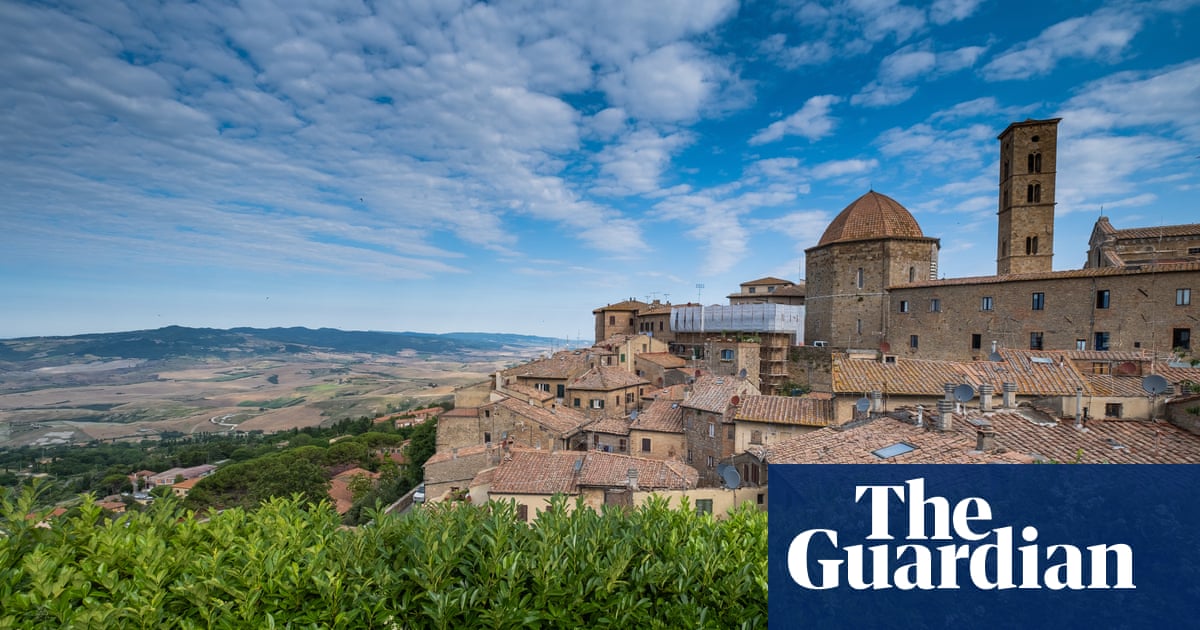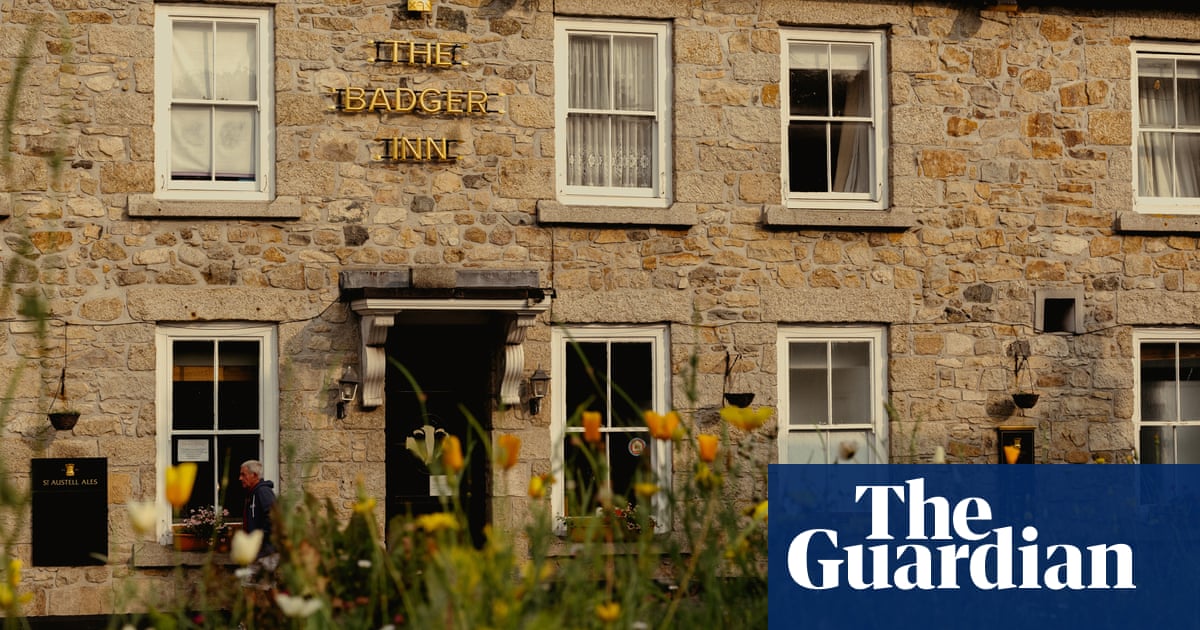
‘When I went from Constance, it was on a small steamer down the Rhine to Schaffhausen.” So wrote DH Lawrence in 1913. While his lover Frieda Weekley (née von Richthofen) was trying to explain their love affair to her family in Germany, Lawrence decided to walk south across the Alps, to Como and Milan, about 230 miles, taking steamers on the rivers and lakes where possible.
In 2022, I followed him with half an idea for a novel. I took the train to Konstanz and found a pretty little town of stone courtyards and half-timbered houses. But at once my reenactment ran into a hitch: Trockenheit, said the sign on the lakeshore – drought. It was August, the Rhine was unusually low, the steamers couldn’t reach Schaffhausen, only Stein am Rhein. Half the distance.
Lawrence had used his walk to observe the encroachment of industrialisation in the Alps
Still, there was something appropriate about this. Lawrence had used his walk to observe the encroachment of industrialisation in the Alps. He was fascinated and appalled by the way people’s age-old intimacy with the land and its rhythms was being replaced by “the mechanical money principle”. Well, now we have climate change to add to our anxieties. As I boarded my paddle steamer at 9am, it was already far too hot. One of my novel’s protagonists would, I decided, be an expert on ecocriticism.
Lake Constance has Austria to the east, Germany to the north and Switzerland to the south. You’re in the heart of Europe. The steamer headed west into the Rhine, which is wider and bluer than I had imagined. Bathers bobbed near the banks; men in small boats sat hunched over fishing rods. For a couple of hours, we chugged along from one fairytale village to the next. On deck people were constantly jumping to their feet to take photos. “The poignancy of the past,” Lawrence writes, “was almost unbearable, floating there in colour upon the haze of the river.”
Stein am Rhein was another masterpiece of kitsch and quaint, with a cobbled marketplace and old stone fountain. I was struck by the grey and pink frescoes, recently restored, thronging a grand facade and including a sundial where the light is always at the zenith. Tourists turn their backs for selfies. “Not very real,” is Lawrence’s comment. Along the river, as I carried my pack the 12 miles to Schaffhausen, bathers were taking advantage of the absence of the steamers to drift downstream on the sluggish current, calling and waving to each other. There was a dreamy atmosphere of pleasure and denial.
Beyond Schaffhausen, you have to negotiate a tangle of motorway access roads before reaching Rhine Falls, where the whole majestic river plunges 23 metres in what is reputed to be the most powerful waterfall in Europe. All vantage points have been fenced off, so if you want a good view you have to pay. It’s well worth it, yet I can’t help feeling some things should be free.
“Ordinary,” is Lawrence’s complaint about the next stretch of the journey, marching south. “A horrible, average, vigorous ordinariness,” he says. We’re talking carefully cultivated fields, neat rows of vines, a well-swept Swissness about the villages. I enjoyed all this, but got what he meant. Trees had tags indicating their species and date of planting. Vineyards displayed certificates of insurance against hailstorms. Everything was bureaucratised. Each farmhouse bore a date, or dates (1670, restored 1993) and there were any number of plaques telling you about a mill here, an old winepress there. As if life were a museum.
Lawrence slept in the village of Eglisau. “A small forgotten wonderful world,” he finds. Certainly, it was a fabulous place to eat trout and sip fizzy Apfelschorle looking down from a wooden balcony at the strangely blue-green river in the gorge below. My main character, I’ve decided, is taking this walk to recover a romantic past; he has made the trip once before with a lover. But to what end, if, as Lawrence frequently feels, the past is so unreal when preserved in the present. On the other hand, nothing we make these days seems half so alluring as the world our forebears built.
I noticed the Swiss habit of arranging every consumer product in neat little rows: cakes and chocolates, pipes and pocketknives, herb teas, jewels, jams
Leaving the Rhine, you pass through an endless wood planted and managed, as regular notices inform, by the Schweizerischer Forstverein. There’s only one track, for hours, arrow straight, with logs in stacks at intervals. “Mile after mile, to Zurich,” Lawrence writes, “it was just the same … utter soulless ordinariness.” And Zurich itself, when he got there, was “like a most ordinary, average, usual person in an old costume”. He couldn’t bear to spend a single night in the town. I loved it, but did notice the Swiss habit of arranging every consumer product in neat little rows: cakes and chocolates, pipes and pocketknives, herb teas, jewels, jams, each item rigorously aligned, neatly labelled, clearly priced. There was even a Condomeria, with condoms and vibrators in pink and purple ranks. I wonder what my lovesick protagonist will make of them.
The next day began with a steamer trip on the Zurichsee, then a beautiful climb through dense natural woods from Adliswil to Felsenegg, where the terrace cafe at the top offered a vast panorama – “Zurich and its lake laid out before me like a relief map”, Lawrence says – and the first sight of the mountains to the south: a delicate white silhouette above blue hills promising, at last, something quite out of the ordinary.
Sure enough, it was the long climb toward the Gotthard which was the climax and challenge of this trip. First, you have the hike to Lucerne, “irritating as ever,” the sublimely grumpy Lawrence decides, “like the wrapper round milk chocolate”– then a magnificent three-hour lake trip down to Flüelen in a steamer that announced it was built in 1906, hence perhaps the very boat Lawrence sailed in. The water was weirdly luminous under heavy cloud which opened up now and then on glimpses of dizzying crags, giving the impression you’re being transported to a world ever more rugged and remote.
But this is an illusion. Lawrence was glad to be in a landscape no longer entirely in thrall to mankind: “I set off up the valley,” he says, “between the close, snow-topped mountains, whose white gleamed above me as I crawled, small as an insect, along the dark, cold valley below.” He could walk on the main road, because there were no cars, just the occasional cart or carriage, and though from time to time “railway sidings and haphazard villas for tourists” irked him, as soon as he was away from them he heard nothing but the roar and splash of the river Reuss, “rustling and rushing and wavering, but never for a second ceasing”.
Not so today. “The Gotthard autobahn was completed in 1986,” one of the regular information panels along Swiss National Trail 7 kindly informed me, “making the upper Reuss valley accessible for day trips.” As I read, in fact, the babble of the river mingled with the rumble of heavy vehicles. You despair of getting away from them. Lawrence simply had no idea. You raise your head and start to look for remote paths high up on the mountainside, anything to get away from this interminable motorised willfulness, hammering down from Frankfurt to Milan. And here I saw the chance of injecting some drama into my novel.
My trek suddenly becomes infinitely more dangerous than Lawrence’s, climbing higher and higher, pursued by noise
My trek suddenly became infinitely more dangerous than Lawrence’s, climbing higher and higher, pursued by noise, until on the second day I lost myself in thick raincloud, my phone battery packed up and I was in trouble, stumbling across slippery scree, the path quite lost, saved only at last by the wraithlike appearance of the Maria Hilf Kapelle, a tiny church clinging to a bank of granite. Inside, two boxes of matches and a money box invite me to make a donation and light a candle.
To climb the Devil’s Gorge to Andermatt, your path zigzagging above and below a fast road, amid the remnants of abandoned railways, tunnels and bridges, or again to descend the Ticino valley into Italy, constantly looking for ways to escape the autostrada without risking life and limb, is not for everyone. But those who do it will get a powerful sense of how radically the Earth has been wounded to give us rapid communication and industrial growth.
It is a totally different thing, as Lawrence was aware, to know something intellectually and to feel it in the flesh, though there were unexpected consolations: small towns – Giornico, Biasca – marooned in a charming past, free from all kitsch, precisely because the autostrada had destroyed all tourism. Or the moment of blistering heat when I was able to strip off and lie naked in the river right beneath the motorway, which, since sound travels upward, seemed strangely silent. Not to mention all the ideas – manna for a writer – that this combination of awesome nature and stubborn human endeavour inevitably inspired. By the time Lake Como was shimmering before me, I felt pretty confident I had my novel. I would call it Mr Geography.












